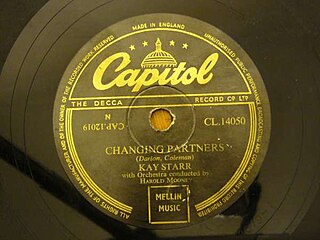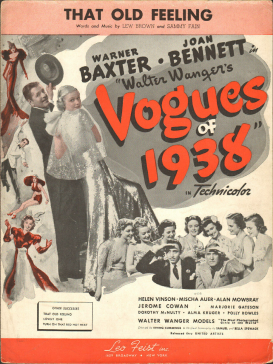Related Research Articles

Sammy Kaye was an American bandleader and songwriter, whose tag line, "Swing and Sway with Sammy Kaye", became one of the most famous of the Big Band Era. The expression springs from his first hit single in 1937, "Swing and Sway". He was the first to record and release the standard "Blueberry Hill" in 1940. During World War II, he co-wrote and recorded the anthemic "Remember Pearl Harbor". He was the first to record and release the no. 1 song "Daddy" in 1941. His signature tune was "Harbor Lights", a number-one hit in 1950.
"Blueberry Hill" is a popular American song published in 1940 first recorded and released by Sammy Kaye in 1940 on RCA Victor. It is best remembered for its 1950s rock and roll version by Fats Domino.
"Walkin' My Baby Back Home" is a popular song written in 1930 by Roy Turk (lyrics) and Fred E. Ahlert (music).
"Hey There" is a show tune from the musical play The Pajama Game, written by Richard Adler and Jerry Ross. It was published in 1954. It was introduced by John Raitt in the original production. In the show, Sid sings it to a recording device, telling himself that he's foolish to continue his advances to Babe. He plays the tape back, and after responding to his own comments, sings a duet with himself.
"(How Much Is) That Doggie in the Window?" is a popular novelty song written by Bob Merrill and first registered on September 25, 1952, as "The Doggie in the Window". On January 27, 1953, its sheet music was published in New York as "(How Much Is) That Doggie in the Window".
"Why Don't You Believe Me?" is a popular song written by Lew Douglas, King Laney, and Roy Rodde and published in 1952.
"It's April Again" is a popular song that first appeared in the 1952 film Moulin Rouge. It became a No. 1 hit in the UK Singles Chart when recorded by Mantovani. The music for the film was written by Georges Auric; the original French lyrics were by Jacques Larue, with the English words by William Engvick. The Auric-Engvick song was published in 1953.

"Changing Partners" is a pop song with music by Larry Coleman and lyrics by Joe Darion, published in 1953. The best-known recording was made by Patti Page. It was also recorded the same year by Dinah Shore, Kay Starr and Bing Crosby.
"Have You Heard?" is a popular song written by Lew Douglas, Frank LaVere and LeRoy W. Rodde and published in 1952. The biggest hit version was recorded by Joni James in 1952, charting the next year. The recording by Joni James was released by MGM Records as catalog number 11390. It first reached the Billboard magazine charts on December 27, 1952 and lasted 14 weeks on the chart, peaking at #4. The flip side was "Wishing Ring."
"Pretend" is a popular song, written in 1952 by Dan Belloc, Lew Douglas, Cliff Parman and Frank Levere.

"That Old Feeling" is a popular song about nostalgia written by Sammy Fain, with lyrics by Lew Brown. It was published in 1937.
"Charmaine" is a popular song written by Ernö Rapée and Lew Pollack. The song was written in 1926 and published in 1927. However, Desmond Carrington on his BBC Radio 2 programme marked the song's writing as being in 1913.

"I'll See You in My Dreams" is a popular song and jazz standard, composed by Isham Jones, with lyrics by Gus Kahn, and published in 1924. It was recorded on December 4 that year, by Isham Jones conducting Ray Miller's Orchestra. Released on Brunswick Records, it charted for 16 weeks during 1925, spending seven weeks at number 1 in the United States. Other popular versions in 1925 were by Marion Harris; Paul Whiteman; Ford & Glenn; and Lewis James; with three of these four reaching the Top 10.
"I Had the Craziest Dream" is a popular song which was published in 1942. The music was written by Harry Warren, the lyrics by Mack Gordon.
Lilian Patricia Lita Roza was an English singer best known for her 1953 recording "(How Much Is) That Doggie in the Window?", which reached No. 1 on the UK Singles Chart. She was the first British woman to have a No. 1 hit in the UK chart.

Sue Thompson was an American pop and country music singer. She is best known for the million selling 1961 hits "Sad Movies " and "Norman", "James " (1962), and "Paper Tiger" (1965).
"Tell Me You're Mine" is a song written by Ronald L. Fredianelli and Dico Vasin and performed by The Gaylords. It reached number 2 on the U.S. pop chart and number 3 on Cashbox in 1953.
"Hey! Jealous Lover" is a song written by Sammy Cahn, Bee Walker, and Kay Twomey and performed by Frank Sinatra featuring Nelson Riddle and His Orchestra. It reached #3 on the U.S. pop chart in 1956.
Charles Albertine was an American musician, composer, and arranger of the space-age pop era. He is best known as an arranger for Les and Larry Elgart, Sammy Kaye, and The Three Suns, and as the composer of Bandstand Boogie. He also composed music for many television shows.
References
- ↑ "Swing & Sway With Sammy Kaye* - One For The Wonder (Vinyl)". Discogs.com. Retrieved 2016-01-20.
- ↑ Roberts, David (2006). British Hit Singles & Albums (19th ed.). London: Guinness World Records Limited. p. 77. ISBN 1-904994-10-5.
- ↑ "Lita Roza - (Poor Little Robin) Walkin' To Missouri/ Half As Much (Shellac)". Discogs.com. Retrieved 2016-01-20.
- ↑ "Sue Thompson - Walkin' To Missouri (Vinyl)". Discogs.com. Retrieved 2016-01-20.
- ↑ "Russ Morgan And His Orchestra - Let's Dance With Russ Morgan And His Orchestra (Vinyl, LP)". Discogs.com. Retrieved 2016-01-20.